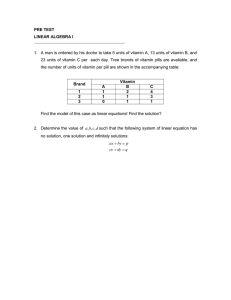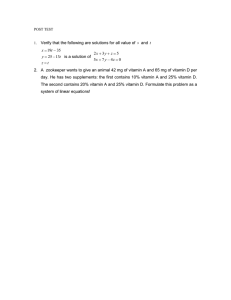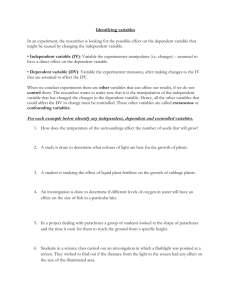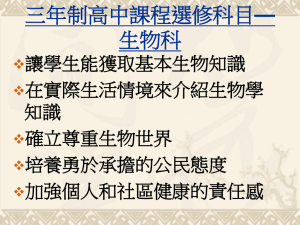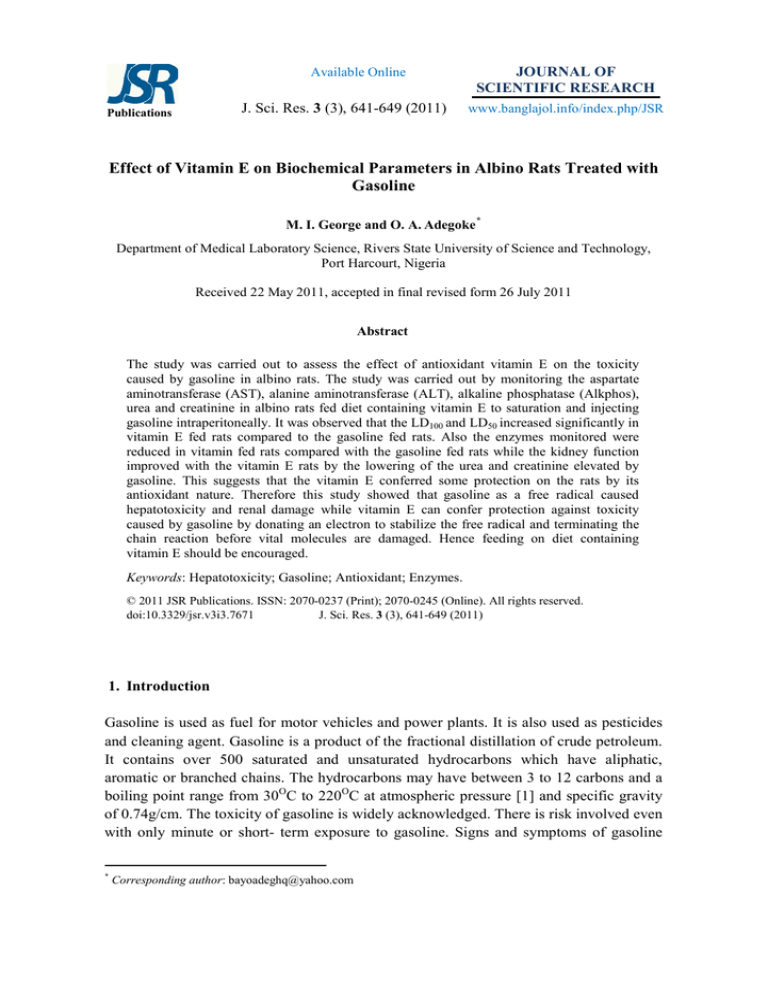
Available Online
J. Sci. Res. 3 (3), 641-649 (2011)
Publications
JOURNAL OF
SCIENTIFIC RESEARCH
www.banglajol.info/index.php/JSR
Effect of Vitamin E on Biochemical Parameters in Albino Rats Treated with
Gasoline
M. I. George and O. A. Adegoke *
Department of Medical Laboratory Science, Rivers State University of Science and Technology,
Port Harcourt, Nigeria
Received 22 May 2011, accepted in final revised form 26 July 2011
Abstract
The study was carried out to assess the effect of antioxidant vitamin E on the toxicity
caused by gasoline in albino rats. The study was carried out by monitoring the aspartate
aminotransferase (AST), alanine aminotransferase (ALT), alkaline phosphatase (Alkphos),
urea and creatinine in albino rats fed diet containing vitamin E to saturation and injecting
gasoline intraperitoneally. It was observed that the LD100 and LD50 increased significantly in
vitamin E fed rats compared to the gasoline fed rats. Also the enzymes monitored were
reduced in vitamin fed rats compared with the gasoline fed rats while the kidney function
improved with the vitamin E rats by the lowering of the urea and creatinine elevated by
gasoline. This suggests that the vitamin E conferred some protection on the rats by its
antioxidant nature. Therefore this study showed that gasoline as a free radical caused
hepatotoxicity and renal damage while vitamin E can confer protection against toxicity
caused by gasoline by donating an electron to stabilize the free radical and terminating the
chain reaction before vital molecules are damaged. Hence feeding on diet containing
vitamin E should be encouraged.
Keywords: Hepatotoxicity; Gasoline; Antioxidant; Enzymes.
© 2011 JSR Publications. ISSN: 2070-0237 (Print); 2070-0245 (Online). All rights reserved.
doi:10.3329/jsr.v3i3.7671
J. Sci. Res. 3 (3), 641-649 (2011)
1. Introduction
Gasoline is used as fuel for motor vehicles and power plants. It is also used as pesticides
and cleaning agent. Gasoline is a product of the fractional distillation of crude petroleum.
It contains over 500 saturated and unsaturated hydrocarbons which have aliphatic,
aromatic or branched chains. The hydrocarbons may have between 3 to 12 carbons and a
boiling point range from 30OC to 220OC at atmospheric pressure [1] and specific gravity
of 0.74g/cm. The toxicity of gasoline is widely acknowledged. There is risk involved even
with only minute or short- term exposure to gasoline. Signs and symptoms of gasoline
*
Corresponding author: bayoadeghq@yahoo.com
642
Effect of Vitamin E
toxicity are associated with abdominal pain, anemia, anorexia, anxiety, bone pain, brain
damage, confusion, constipation, convulsions, dizziness, drowsiness, fatigue, headaches,
hypertension, inability to concentrate, indigestion, irritability, loss of appetite, loss of
muscle co-ordination, memory difficulties, miscarriage, muscle pain, pallor, tremors,
vomiting and weakness. These effects are highly contributed by the presence of lead and
benzene in gasoline. Target tissues are the bones, brain, heart, kidneys, liver, nervous
system and pancreas [2]. Gasoline, a crude petroleum product caused dose dependent
decrease in haemoglobin concentration and white blood cell counts [3,4].
Antioxidants are molecules, which can safely interact with free radicals and terminate
the chain reaction, before vital molecules are damaged. Although there are several
enzymes systems within the body that scavenge free radicals, the principal micronutrient
(vitamin) antioxidants are vitamins E, beta-carotene, and vitamin C. Vitamin E is
synthesized by plants and is an antioxidant that protects all membranes and other fatsoluble parts of the body, such as low-density lipoprotein cholesterol, from damage. Some
of the food sources of vitamin E include Alfalfa sproats, avocado, bee pollen, carrot,
chickweed, cumfrey root, dadelion root, garlic, greens (leafy), lemon grass, marsh mallow
and mushrooms. Others are seeds, sunflower seeds and sunlight. Vitamin E is absorbed
from the intestine through lymph. It circulates through the body plasma in associations
with Beta-lipoprotein. Vitamin E has been used in connection with the following
conditions like anemia, burns, epilepsy, immune function for elderly people, intermittent
claudication, rheumatoid arthritis, tardire dyskinesia, alzheimer’s disease, Angina,
atherosclerosis, bronchitis, cold sores, down’s syndrome, dysmenorrhea, heart attack,
leukoplakia, osteoarthritis, Parkinsons disease, preclampsia, stroke, skin ulcers, infertility,
age related cognitive decline etc [5]. The aim of this study is to determine the effect of
vitamin E on hepatotoxic and renal effect caused by gasoline in albino rats using aspartate
aminotransferase (AST), alanine aminotransferase (ALT), alkaline phosphatase
(Alkphos), urea and creatinine as indicators.
2. Materials and Methods
Test animals
Eighty (80) male albino rats of 0.175 kg average weight were obtained from the
department of pharmacology and Toxicology, university of Port Harcourt animal house.
The rats were fed ad libitum with rat pellets and water and acclimatize for two weeks prior
to commencement of study in four separate groups. The petrol sample (gasoline) used in
this study was obtained directly from AP filling station, University of Port Harcourt, near
Port Harcourt. The vitamin supplements (E) used for the study was obtained from a
pharmacy store, Ebus Pharmacy, Port Harcourt.
Animal studies
This group consisted of 20 rats, which were divided into 5 cages, each cage containing 5
rats. Preliminary study was carried out to determine LD100 and LD50 of gasoline by
M. I. George and O. A. Adegoke, J. Sci. Res. 3 (3), 641-649 (2011)
643
intraperitoneal administration of gasoline at 80, 160, 200 and 240 g/kg while the last
group was given normal saline to serve as control and the number of death monitored in
all the groups and recorded. The LD50 was done by arithmetic method of Karber [6].
This group consisted of 20 rats, which were divided into 5 cages, each cage containing
4 rats. Preliminary study was carried out to determine LD100 and LD50 of gasoline by
intraperitoneal administration of gasoline at 80, 160, 200 and 240 g/kg while the last
group was given normal saline to serve as control and the number of death monitored in
all the groups and recorded. The LD50 was done by Arithmetic method of Karber [6].
Twenty five (25) albino rats divided into 5 groups of 5 albino rats each were
administered with gasoline intraperitoneally at concentrations of 20, 40, 80 and 160g/kg
while the control rats in group 1 were administered with 0.9% normal saline. Signs and
symptoms of toxicity due to gasoline were observed in the rats. The rats were considered
dead when they no longer responded to agitation.
Thirty five albino rats divided into 7 groups for vitamin E were fed with diet
containing vitamin E in their feed for 2 weeks, after which the rats were administered with
gasoline intraperitoneally at concentrations of 40, 80, 120, 160, 200 and 240g/kg. The
control rats in cage 1 were administered with 0.9% normal saline. Signs and symptoms of
toxicity were observed. The dose difference, number of dead rats and the means death at
each dose level were recorded. The LD50was carried out using Arithmetic method of
Karber [6].
Biochemical studies
Blood samples were collected from rats in groups 1, 2 and 4, using the tail of the rats.
Colour reaction for tocopherol (vitamin E) was tested for in these groups. Groups 2 and 4
rats tested positive, while group one rats tested negative. The method of saturation was
based on the property of tocopherol to give under the action of strong oxidants (for
example concentrated nitric acid), compounds of quinoid structure colored red [7].
Determination of ALT and AST was done by monitoring the concentrations of
pyruvate hydrazone formed with 2, 4 dinitrophenylhydrazine. 0.5ml of buffer solution
was dispensed into test tubes labeled blank, sample, control blank and control respectively
for AST and ALT respectively. 0.1ml of sample and control was dispensed into their
respective test tubes. All the tubes were incubated at 37ºC for 30minutes. 0.5ml of 2, 4
dinitrophenylhydrazine was dispensed into all test tubes. 0.1ml of sample and control was
dispensed into their respective blank test tube. The contents of each test tube was mixed
and allowed to stand for 20minutes at 25ºC. 5ml of 0.4N sodium hydroxide was added to
each tube, mixed and read at 550nm against the respective blank prepared. The activity of
the unknown was extrapolated from the calibration curve already prepared [8].
Alkaline phosphatase activity was done by Phenolphthalein Monophosphate method
.The test tubes were respectively labeled sample, standard and control. 1.0ml of distilled
water was pipetted into each tube followed by a drop of the substrate into each test tube.
All the test tubes were incubated at 37ºC for 5minutes. 0.1ml of sample, standard and
644
Effect of Vitamin E
control were dispensed into their respective test tubes. The test tubes were incubated at
37ºC for 20minutes. 5ml of colour developer was added to each test tube, mixed and read
at 550nm using water as blank. The activity of sample was calculated using the
absorbance of sample against absorbance of standard multiplied by concentration of
standard [9].
Urea estimation was done by Urease-Berthelot colorimetric method. Ten (10)
microlitre of sample, standard, control and distilled water was pipette into test tube
labeled sample, standard control and blank respectively. Hundred (100) µl of urea reagent
1 was added to all the tubes and incubated at 37oC for 10 minutes. 250 µl of urea solutions
2 and 3 was added to all the tubes, mixed and incubated at 37OC for 15 minutes. The
absorbance of the sample, control and standard were read at 546nm against the content of
the blank tube. The activity of sample was calculated using the absorbance of sample
against absorbance of standard multiplied by concentration of standard [10].
Creatinine estimation was done by Jaffe’s colorimetric method. Five hundred (500) ml
of sample, standard, control and distilled water was pipette into test tube labeled sample,
standard control and blank, respectively containing five hundred (500) ml of
trichloroacetic acid (TCA).The contents were mixed and spun at 2500rpm for 10minutes.
1000 ml of supernatant from each tube was added into respectively labeled test tube
containing 1000 ml of reagent mixture of picric acid and sodium hydroxide (500 ml
each).The contents were mixed and stand at 25OC for 20 minutes. The absorbance of the
sample, control and standard were read at 546nm against the content of the blank tube.
The concentration of sample was calculated using the absorbance of sample against
absorbance of standard multiplied by concentration of standard [11].
Statistical analysis
The biochemical data were subjected to some statistical analysis. Values were reported as
mean + SEM while student’s t-test was used to test for differences between treatment
groups using Statistical Package for Social Sciences (SPSS) version 16.A value of P<0.05
was accepted as significant.
3. Results
The result presented in Table 1 showed an increase in LD100 in vitamin E treated albino
rats (240+0.175g/kg) compared with the gasoline treated (160+0.175g/kg). Also the LD50
was increased by vitamin E( 140+0.175g/kg) treated rats compared with gasoline treated.
(95+0.175g/kg).
There was also significant difference in alkaline phosphatase activity (U/L) of 76
+8.33, 322+24.03, 420+91.65, 574+14.00 in gasoline treated compared with 40+5.77,
80+11.55, 89+12.42, 90+5.77 at concentrations of 40,80, 120 and 160g/kg, respectively
while 98+6.11 and 110+5.77 were obtained at concentrations of 200 and 240g/kg
respectively.
M. I. George and O. A. Adegoke, J. Sci. Res. 3 (3), 641-649 (2011)
645
Table 1. Median lethal dose in rats treated with gasoline.
Gasoline treated without vitamin E
Cage
Gasoline treated with vitamin E
Dose level (g/kg)
No. dead
Dose level (g/kg)
No. dead
1
0.00
0
0.00
0
2
20.00
1
40.00
0
3
40.00
2
80.00
1
4
80.00
3
120.00
2
5
160.00
4
160.00
2
6
200.00
3
7
240.00
4
LD50
LD50ip = 95 + 0.175g/kg
LD50ip = 140 + 0.175g/kg
There was also dose dependent increase in aspartate amino transferase (AST) activity
of gasoline treated rats compared with vitamin E treated rats (Table 2). The activities
(U/L) of 12+1.15, 141+9.00, 156+18.33, 167+9.29 and 176+15.88 in gasoline was
significantly different from 16+0.58, 70+11.54,120+11.54 and 140+20 obtained in
vitamin E treated at concentrations of 40, 80, 120 and 160g/kg, respectively while
150+11.54 and 160+7.64 were activities at concentrations of 200 and 240g/kg.
Table 2. Effect of vitamin E on hepatic enzymes in rats treated with gasoline.
Alkaline phosphatase
Conc.
(g/kg)
Aspartate aminotransferase
GT without GT with P value GT without
vitamin E vitamin E
vitamin E
GT with
vitamin E
Alanine aminotransferase
P value GT without GT with P
vitamin E vitamin E value
0
36+3.46
29+0.58
0.206
12+1.15
16+0.58
0.020
13+1.52
8+1.15 0.102
40
76+8.33
40+5.77
0.087
141+9.00
16+1.53
0.005
86+8.33
7+0.58 0.010
80
322+24.03
80+11.55 0.020
156+18.33
70+11.54
0.100
171+36.93
22+3.47 0.051
120
420+91.65
89+12.42 0.058
167+9.29
120+11.54 0.127
177+8.88
23+3.00 0.002
90+5.77
176+15.88
140+20.00 0.259
196+12.22
33+6.25 0.009
160
574+14.00
0.002
200
98+6.11
150+11.54
34+3.06
240
110+ 5.77
160+7.64
45+7.64
GT = Gasoline treated.
Also dose dependent increase in alanine amino transferase (AST) activity was
observed in gasoline treated rats compared with vitamin E treated rats. The activities
(U/L) of 86+8.33, 171+36.93, 177+8.88 and 196+12.22 in gasoline was significantly
646
Effect of Vitamin E
different from 7+0.58, 22+3.47, 23+3.00 and 33+6.25 obtained in vitamin E treated rats at
concentrations of 40,80, 120 and 160g/kg, respectively while 34+3.06 and 45+7.64 were
activities at concentrations of 200 and 240g/kg.
The result of urea concentration (mmol/l) in gasoline treated showed 8.2+1.04,
10.5+0.29, 12.8+2.56 and 15.7+2.93 compared with 5.5+0.50, 5.3+0.35, 6.6+1.70 and
6.9+0.49 at concentrations of 40,80, 120 and 160g/kg, respectively while 7.2+0.92 and
10.6+0.31 were concentrations at 200 and 240g/kg respectively (Table 3). Creatinine
concentration (μmol/L) in gasoline treated albino rats was 166+16.00, 190+5.77,
210+60.00 and 380+29.06 while in vitamin E treated the concentrations were 50+5.77,
69+4.94, 69+1.00 and 69+1.00 at gasoline concentrations of 40, 80, 120 and 160g/kg,
respectively while 70+10.00 and 160+5.77 were creatinine concentration obtained at 200
and 240g/kg.
Table 3. Effect of vitamin E on urea and creatinine in rats treated with gasoline.
Urea
Conc.
(g/kg)
Creatinine
GT without
vitamin E
GT with
vitamin E
P value
GT without
vitamin E
GT with
vitamin E
P value
0.00
6.4+0.61
5.0+0.58
0.050
70+5.78
60+5.78
0.423
40.00
8.2+1.04
5.5+0.50
0.054
166+16.00
50+5.77
0.032
80.00
10.5+0.29
5.3+0.35
0.014
190+5.77
69+4.94
0.000
120.00
12.8+2.56
6.6+1.70
0.149
210+60.00
69+1.00
0.144
160.00
15.7+2.93
6.9+0.49
0.114
380+29.06
69+1.00
0.011
200.00
7.2+0.92
70+10.00
240.00
10.6+0.31
160+5.77
GT = Gasoline treated.
Table 4. Overall effect of vitamin E on biochemical parameters in rats treated
with gasoline.
Parameter
Gasoline treated
without vitamin E
Gasoline treated with
vitamin E
P value
AST (U/L)
160.00 + 7.60
109.00 + 23.00
0.05
ALT (U/L)
162.50 +25.80
21.00 + 5.0
0.0001
ALP (U/L)
348.00 + 104.00
84.50 + 24.00
0.001
Creatinine (μmol/L)
236.50 + 48.67
82.00 + 8.00
0.001
Urea (mmol/L)
11.80 + 1.60
7.00 + 0.80
0.05
M. I. George and O. A. Adegoke, J. Sci. Res. 3 (3), 641-649 (2011)
647
There was significant decrease in AST (U/L) activity of vitamin E treated 109+23
compared with 160+7.6 in gasoline treated. Also there was significant decrease in ALT
activity (U/L) of 21+5 in vitamin E compared with 162.5+25.8 in gasoline treated rats.
Alkaline phosphatase activity was reduced by vitamin E diet to 84.5+ 24.0 from 348+104
obtained in gasoline treated rats. The concentrations of 82+8 and 7.0+ 0.8 obtained for
creatinine (μmol/L) and urea (mmol/L) in vitamin E treated rats were significantly lower
than 236.50+48.67 and 11.8+1.6 obtained in gasoline treated rats as shown in Table 4
below.
4. Discussion
The increase in LD100 and LD50 in vitamins E, treated rats suggested that the treatment
with these vitamins conferred some protection against gasoline toxicity by increasing the
concentration of gasoline that will cause LD100 vis-a-vis LD50. Changes in behavioral
pattern with respect to onset of symptoms (weakness, reduced movement and ataxia, loss
of consciousness, respiratory distress, and coma) and death was faster in the untreated
group than the treated groups. Deaths in the gasoline rats started occurring at 20g/kg
whereas in the vitamin E treated groups, death was recorded from 80g/kg.
The biochemical parameters monitored during the acute toxicity study were aspartate
aminotransferase (AST), alanine amino transferase (ALT), and alkaline phosphatase
(ALP). Other parameters monitored include creatinine (CR) and urea (UR) levels.
Enzymes were also used as markers because they are found in body tissues; they
frequently appear in the serum following cellular injury or sometimes in smaller amounts,
from degraded cells or storage area. Hence serum enzymes levels are often useful in the
diagnosis of particular diseases or physiologic abnormalities [12].
In this study, the four groups examined produced a dose dependent increase in the
levels of the three enzymes. Biochemical studies by Obianime et al. [13] revealed that
gasoline given intraperitoneally induced a time dependent increase in liver enzyme
activity. Wachukwu et al. [3] reported that there was a corresponding increase in the
activity of the liver enzymes, AST, ALT and ALP with increase in the concentration of
petrol while Uboh et al. [14] reported that exposure of male and female rats to 17.8
cm3h-1m-3 of Premium Motor Spirit (PMS) blend unleaded gasoline (UG) vapors for 6
hr/day, 5 days/week for 20 weeks caused hepatotoxicity. Also previous studies observed
that gasoline vapors induced proatherogenic changes in serum lipid profile and signs of
hepatic oxidative stress [15-17], haematotoxicity [18, 19], reproductive toxicity [20] and
nephrotoxicity [21] in male and female rats.
From this study, the increase in activity was highest with ALT, which is more specific
for hepatic diseases than AST and ALP in the untreated group. The result further showed
that in vitamin E treated rats the enzymes were reduced compared with the gasoline
treated rats. This is similar to reports by other authors using vitamins A and E [14]. This
may be attributed to the anti oxidant nature of vitamin E by removing the free radical.
Biological locations can also influence or affect the release of these enzymes. The
increase in these three enzymes may reflect some inflammatory disease or injury to the
liver (hepatocellular disease). Krishan and Veena [22] also observed increase in levels of
648
Effect of Vitamin E
AST, ALT and ALP in serum of fish exposed to 2,3,4 – triaminoazo benzene resulting to
hepatocellular damage. Dheer, et al. [23], Mohssen [24] and Sharpe, et al. [25] are studies
that indicated increase in the activity of liver enzyme following liver damage in fish and
albino mouse exposed to toxic substances.
The kidneys play a special role in concentrating toxic substances within its tubules and
excreting them. These functions render it susceptible to damage by certain chemical
substances. The kidney is the major organ of excretion of metabolites of gasoline
components [26]. Also vitamin E help to ameliorate the kidney function by reducing the
urea and creatinine values. Vitamin E might have aided the kidney to excrete the gasoline
thus protecting the kidney as well as the rats. Vitamin E acts mainly as a free radical chain
breaking antioxidant in liposomes and cellular membrane [27]. The study revealed overall
increases in ALT, AST and alkaline Phosphatase, urea and Creatinine in gasoline treated
rats compared with vitamins E, treated rats. This observation is similar to study by Dede
et al. [4].
Antioxidants are molecules, which interact with free radicals and terminate the chain
reaction before vital molecules are damaged. They donate an electron to stabilize a free
radical. Antioxidants have long been known to reduce the free radical mediated oxidative
stress caused by elements and compounds in the environment [28, 29].The function of
vitamin E in the study was to donate an electron to stabilize a gasoline which is a free
radical.
5. Conclusion
This study has shown that gasoline as a free radical causes hepatotoxicity and renal
damage while feeding on antioxidant vitamin E reversed the hepatotoxicity and the renal
damage.
Acknowledgement
The authors are grateful to the Management of Labmedica Services, Aggrey Road Port
Harcourt for the biochemical analysis and Mr Jide Ogunnowo of Pharmacology
Department, University of Port Harcourt, for his help in the animal study.
References
1. D. V. Hunt, The gasobol handbook (Industrial Press, 1981) ISBN 0-8311-1137-2.
2. M. Pouls, Oral Chelation and nutritional replacement. Health Education Alliance for Life and
Longevity (HEALL), 5:53. (2000).
3. C. K. Wachukwu, E. B. Dede, C. C. Ozoemena, and S. E. Amala, J. Medical Lab. Science 13
(1), 1 (2004).
4. E. B. Dede, C. P. R. Chike, and O. A. Adegoke, The effect of selenium (antioxidant) on
gasoline toxicity in male albino rats (Ratus ratus). African J. Appl. Zool. and Environ.
Biology 6, 128 (2004).
M. I. George and O. A. Adegoke, J. Sci. Res. 3 (3), 641-649 (2011)
649
5. M. G. Traber, Vitamin E, In: Modern Nutrition in Health disease. M. E. Shils et al. (ed.)
(Williams and Wilkins Publications, Baltimore, 1999) pp. 347-362.
6. E. B. Dede and P. S. Igbigbi, Journal of Science, Metascience 111 (1), 1 (1997).
7. E.A. Stroev, and V.G. Makarova, Laboratory Manual in Biochemistry. In: Metabolism
Regulators, (M .R Publishers, Moscow, 1989), Pp 192 – 193.
8. S. Reitman, and S. A. Frankel, Colorimetric method for determination of serum glutamic
oxaloacetic transaminase (SGOT) and serum glutamic pyruvic transaminase (SGPT). American
J. Clinical Pathology 28, 56 (1957).
9. L. A. Babson, S. J. Greeley, C. M. Coleman, and G. D. Philips, Clinical Chemistry 12, 482
(1966).
10. M. W. Weatherburn, Urea estimation. Anal. Chem. 39, 971 (1967).
http://dx.doi.org/10.1021/ac60252a045
11. R. J Henry, Creatinine In: Clinical chemistry, principles and techniques, 2nd edition (Harper and
Row, 1974) p. 525.
12. B. L. Hurtuk and R .G Krefetz, General Properties of enzymes In: Clinical Chemistry,
Principles, Procedures and Correlation, 2nd edition. M. L. Bishop, L. Jannet, E. Duben, and E. P.
Fody (ed.) (J.B. Lippincott Company, 1992) pp. 215-245.
13. A. W. Obianime, V. Akhidue, and N. E. Ekanem, The effects of inhalational, oral and
intraperitoneal administration of gasoline on haematological and biochemical parameters of
albino rats In: Proceedings of XXII scientific conference, Physiological Society of Nigeria,
Ibadan (2001) p. 16.
14. F. E. Uboh, P. E. Ebong, I. B. Umoh, Gastroenterology Research 2 (5), 295 (2009).
15. F. E. Uboh, P. E. Ebong , O. U. Eka, E. U. Eyong, and M. I. Akpanabiatu, Global J Environ
Sci. 4 (1), 60 (2005).
16. F. E. Uboh, M. I. Akpanabiatu, I. S. Ekaidem, P. E. Ebong, and I. B. Umoh, Acta Endocrinol.
(Buc), 4, 23 (2007). http://dx.doi.org/10.4183/aeb.2007.23
17. F. E. Uboh, M. I. Akpanabiatu, M. U. Eteng, P. E. Ebong, and I. B. Umoh, The Internet J.
Toxicol. 4 (2), (2008).
18. F. E. Uboh, M. I. Akpanabiatu, P. E. Ebong, E. U. Eyong, and O. U. Eka, Acta Biol. Szeged.
49, 19 (2005).
19. F. E. Uboh, M. I. Akpanabiatu, I. J. Atangwho, P. E. Ebong, and I. B. Umoh, Acta Toxicol. 15
(1), 13 (2007).
20. F. E. Uboh, M. I. Akpanabiatu, P. E. Ebong, and I. B. Umoh, Acta Toxicol. 15 (2), 125 (2007).
21. F. E. Uboh, M. I. Akpanabiatu, I. J. Atangwho, P. E. Ebong, and I. B. Umoh, Int. J. Pharmacol.
4 (1), 40 (2008). http://dx.doi.org/10.3923/ijp.2008.40.45
22. A. G. Krishan and O. Veena, Bull. Environ. Contam. Toxicol. 25, 136 (1981).
23. J. M. S. Dheer, T. R. Dheer, and C. L. Mahagan, Biochem J. of fish Biol. 30, 577 (1987).
http://dx.doi.org/10.1111/j.1095-8649.1987.tb05785.x
24. Mohssen, Hepatotoxicity Environ. Pollution 96 (3), 383 (1997).
http://dx.doi.org/10.1016/S0269-7491(97)00039-0
25. P. C. Sharpe, R. Mcbride, and G. P. Archbod, Medicine 89 (2), 137 (1996).
26. O. E Ricket, T. S. Baker, J. S. Bus, C. S. Barrow, and R. D Irons, Inhalation toxicology Appl.
Pharmacology 49, 417 (1979).
27. Z. L. Liu, “Antioxidant activity of Vitamin E and C derivatives in membrane mimetic systems”
In: Bioradicals detected by ESR spectroscopy, H. Ohyanishiguch and L. Packer (eds.)
(Birkhauser, V. B., Switzerland, 1995) pp 259-275.
28. E. B. Dede, and C. Ngawuchi, The Effect of Vitamin C on gasoline poisoned rats, In:
Proceedings of Nigeria Environmental Society Conference, 13th Annual General Meeting
Bayelsa State (2003) p. 16.
29. E. B. Dede, C. K. Wachukwu, and C. Ngawuchi, The effect of Vitamin C on the histopathology
of gasoline poisoned rats (Rattus norvegicus), In: Proceedings of the Nigerian Environmental
Society Conference 13th Annual General Meeting, Bayelsa State (2003) p. 16.


